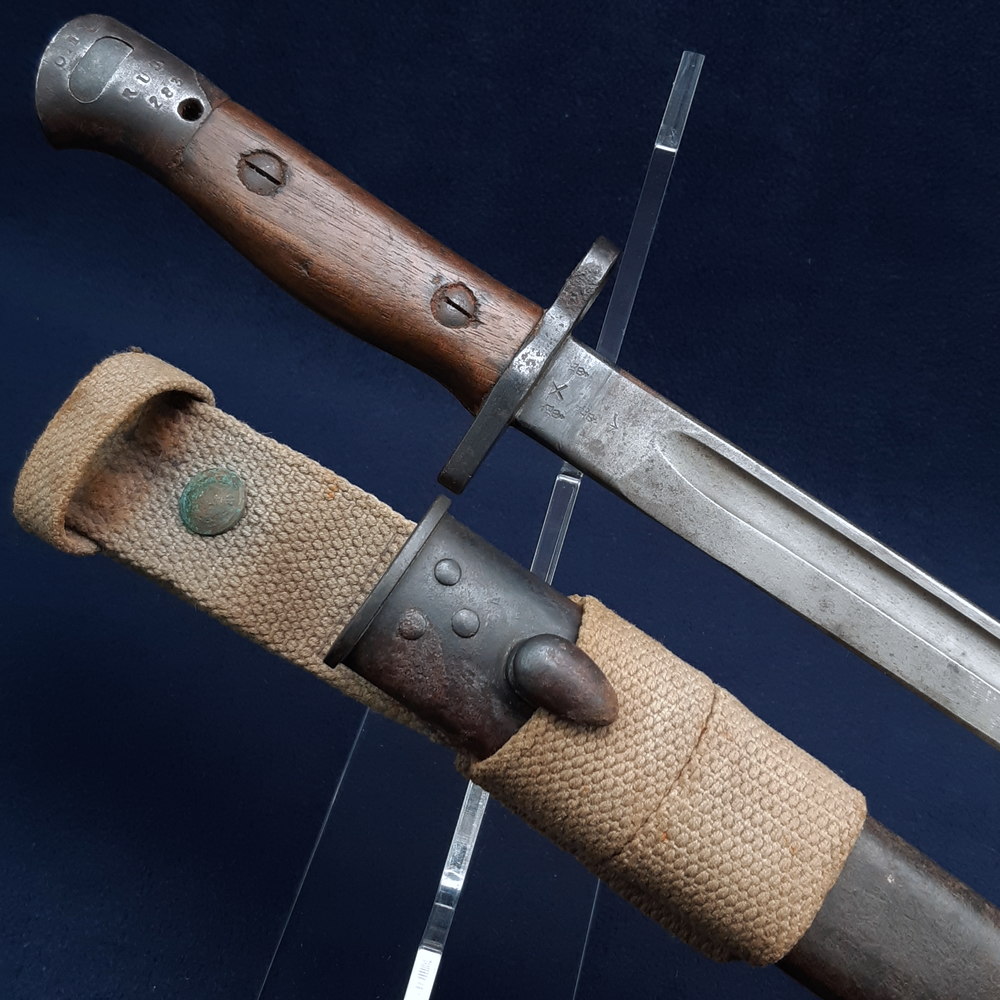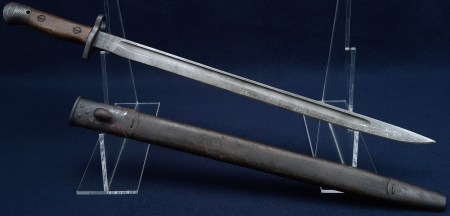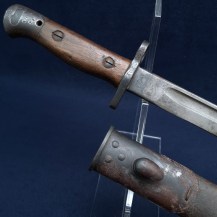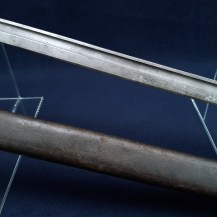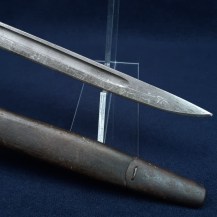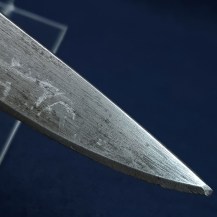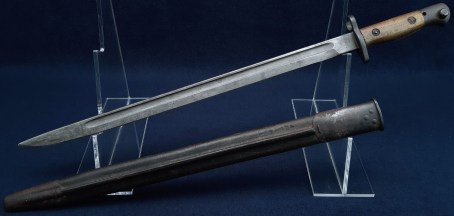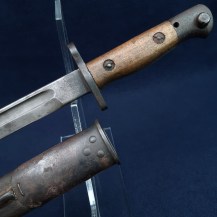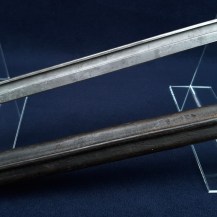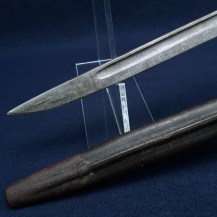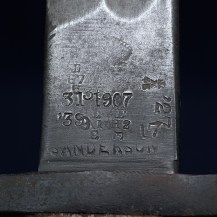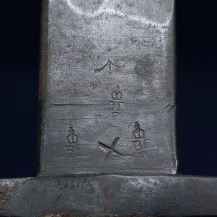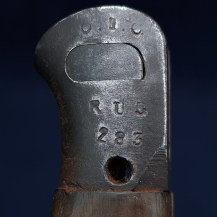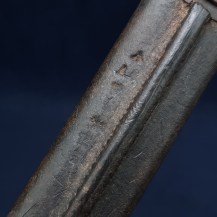British Lee Enfield 1907 Pattern Bayonet, Rugby School Officers Training Corps
Straight single-fullered knife blade, steel hilt with muzzle ring, wood slab grips secured by two screws, steel beaked pommel with oil hole and locking button. Black leather No. 1 Mk 2 scabbard with steel locket & teardrop frog stud and steel chape piece. 1925 Pattern khaki canvas frog with retaining loop and distinctive brass button to clip the frog to the belt.
The ricasso is stamped on one side with a crown, 1907 (the pattern) ‘9 17’, indicating the manufacture date of September 1917, the manufacturer’s mark ‘SANDERSON’, four crown inspection stamps (three with ‘E’ indicating the Royal Small Arms Factory at Enfield), and multiple reissue stamps dated ’27, ’31 and ’39. On the other side it is stamped with a ‘broad arrow’ War Department stores mark, three more crown inspection stamps with ‘E’, and an ‘X’ indicating that it passed a manufacturer’s bending test.
The pommel is stamped with ‘O.T.C’ over ‘RUG’ over ‘283’. This indicates that this was bayonet number 283 used by the Rugby School OTC (Officers’ Training Corps). The throat piece of the scabbard is stamped with a diamond-shaped manufacturer’s mark. The leather of the scabbard is stamped next to the seam with two further crown inspection marks, a broad arrow and an illegible mark which would be the manufacture date - all these marks being faint from rubbing.
A large number of volunteer units sprang up across the United Kingdom during the late 1850s after a national appeal by the Secretary of State for War, due to a perceived threat of invasion of Britain by France. Oxford and Cambridge universities were very quick to respond with the formation of their own units of Rifle Volunteers, and some schools also followed suit, Rugby being one of the first wave of six schools to form their own Corps in 1860. As years went by the number of school units only increased until by 1898 there were 39, with another surge of interest due to the Boer War nearly doubling that number by 1902.
These school units provided early experience for young men who would then be in a good position to move up to the university units and perhaps a military career afterward. There was lively competition between Corps for shooting prizes in particular, with Rugby one of the most successful – although it may be said that success came in part with a school’s willingness to spend on equipment and training.
The Officers’ Training Corps were established in 1906 as part of the wide-ranging Haldane Reforms to the British Army’s structure. The OTCs were intended to alleviate the shortage of trained officers in the various volunteer units (Militia, Yeomanry, Volunteer Force and Reserve of Officers) by forming a system of junior training units in public schools and senior ones in universities. Some of the junior OTCs were formed out of the existing school Cadet Corps, which by this date numbered more than fifty, while senior OTCs were often formed from the university units.
During WW1 the OTCs became training units for supplying officers to the regiments, an OTC Certificate generally considered full qualification to become an officer, although some individuals chose for various reasons to enlist in the ranks. Rugby School OTC supplied 291 recruits, all of them gazetted officers, between August 1914 and March 1915.
The Rugby School Cadet Corps still exists today as part of the Combined Cadet Force (CCF), with Army, Royal Marines and RAF contingents. Under the modern Army structure it serves as a leadership and training organisation, teaching a number of military skills but with no obligation to go on to full military service.
Because of its features this bayonet must postdate 1910, and was probably issued to replace the 1903 Pattern bayonets that were initially issued to school Corps. Its frog is quite a scarce pattern: the 1925 Pattern frog was issued to the RAF and in fact was not made in khaki until 1932 when the Canadian government appears to have ordered a number of them from the Mills Equipment Company. The 1937 Pattern generally replaced these so it may have been handed down as surplus and found its way to an OTC unit – as its reissue marks attest this bayonet was still in use as of 1939. The scabbard is not actually fully fitted into it – it arrived this way and I do not wish to force the stiff canvas too much to get the frog stud into it, although I think there is enough give.
The blade has a matt parkerised finish with streaks of rubbing, some scratches and spots of light patination. Some small nicks to the sharpened edge near the tip, the tip rounded. The blued band at the shoulder of the blade is intact. The hilt, pommel and scabbard fittings are blued with some light rubbing on raised edges, but have also been impacted by rust leading to areas of moderate to heavy pitting and encrustation, the latter most notable on the throat piece of the scabbard. While this is removable by polishing, that would also remove the remaining blueing. Only a few small dents to the wood grips. The leather scabbard body has some light dents and surface abrasion. All the scabbard’s stitching remains intact.

